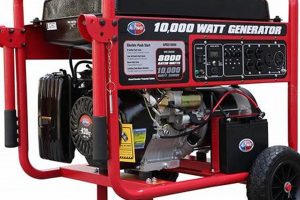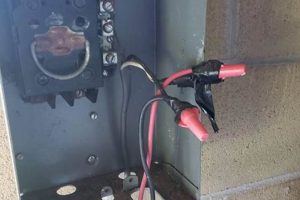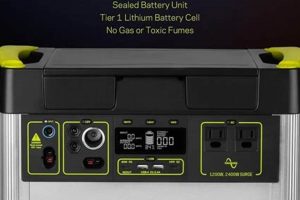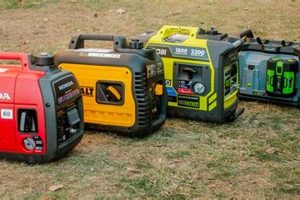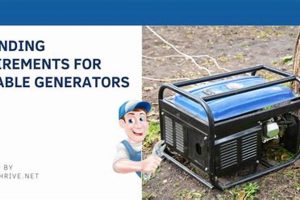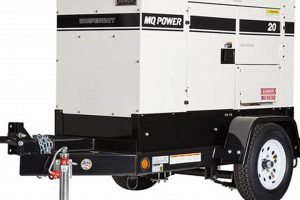A transfer switch system designed for portable generators facilitates a safe connection to a home’s electrical system. This setup typically includes an outdoor-rated power inlet box mounted on an exterior wall, connected to a transfer switch inside. This configuration allows homeowners to power essential circuits during outages by safely connecting their portable generator to the inlet box. The system isolates the generator power from the utility grid, preventing backfeeding and ensuring the safety of utility workers.
These systems offer a convenient and cost-effective solution for backup power. By powering only essential circuits, they maximize the generator’s output and runtime while minimizing fuel consumption. Historically, connecting portable generators directly to household appliances or the main electrical panel posed significant risks. The development of these dedicated transfer switch systems represents a substantial improvement in safety and efficiency for homeowners utilizing portable generators for emergency power.
Further exploration will detail specific components, installation procedures, safety considerations, and operational best practices for these essential backup power systems. Understanding the nuances of proper installation and operation is crucial for maximizing safety and efficiency.
Safety and Operational Tips for Generator Transfer Switch Kits
Safe and effective use of a generator transfer switch kit requires careful attention to several key factors. These tips emphasize critical procedures and best practices to ensure optimal performance and prevent hazards.
Tip 1: Professional Installation is Recommended: Electrical work should be performed by qualified electricians. Incorrect wiring can lead to dangerous conditions, including fire and electrocution.
Tip 2: Proper Sizing is Crucial: Select a transfer switch and power inlet box rated for the generator’s wattage output. Overloading the system can damage the generator and create a fire hazard.
Tip 3: Never Connect to the Main Panel Directly: Direct connection to the main electrical panel without a transfer switch creates a backfeeding risk, endangering utility workers and potentially damaging appliances.
Tip 4: Disconnect from Utility Power Before Operating: Engage the transfer switch to isolate the generator power from the utility grid before starting the generator. This prevents backfeeding and ensures safe operation.
Tip 5: Operate the Generator Outdoors: Generator exhaust contains carbon monoxide, a deadly gas. Operate the generator in a well-ventilated area, far from windows, doors, and vents.
Tip 6: Regularly Inspect Components: Periodically check the power inlet box, wiring, and transfer switch for signs of damage or wear. Replace any damaged components immediately.
Tip 7: Adhere to Local Codes and Regulations: Installation must comply with all applicable local electrical codes and regulations. Consult with local authorities for specific requirements.
Adhering to these safety precautions and operational guidelines will ensure the safe and reliable performance of the generator transfer switch kit, providing crucial power during outages while mitigating potential risks.
By understanding these essential operational and safety considerations, users can effectively leverage these systems to ensure a safe and reliable source of backup power during critical situations. The concluding section will provide further resources and guidance for continued learning and support.
1. Safety
Safe operation of a portable generator connected through a transfer switch kit is paramount. Improper installation or use can lead to serious hazards, including fire, electrocution, and carbon monoxide poisoning. Understanding key safety considerations is crucial for mitigating these risks.
- Preventing Backfeeding:
Backfeeding occurs when generator power flows back into the utility grid, posing a lethal threat to utility workers. A transfer switch isolates the generator from the utility lines, preventing this dangerous reverse flow. Without a properly installed transfer switch, electricity from the generator can energize downed power lines, creating a significant electrocution hazard for anyone coming into contact with them.
- Carbon Monoxide Poisoning Prevention:
Generators produce carbon monoxide, an odorless, colorless, and deadly gas. Operating a generator indoors or in poorly ventilated areas can lead to fatal carbon monoxide buildup. Proper ventilation and placement are crucial; the generator must be operated outdoors, away from windows, doors, and vents. Even seemingly open areas can trap carbon monoxide if not adequately ventilated.
- Fire Hazard Mitigation:
Overloading a generator or using improperly sized wiring can cause overheating and potential fires. The transfer switch kit must be appropriately rated for the generator’s wattage output. Overloading the system can damage the generator, wiring, and connected appliances, significantly increasing the risk of fire. Ensuring proper grounding is also essential for fire prevention.
- Electrical Shock Prevention:
Improper wiring and grounding during installation can create electrical shock hazards. Qualified electricians should install transfer switch kits to ensure compliance with electrical codes and proper grounding procedures. Wet conditions further exacerbate the risk of electrocution, requiring extra caution during operation in inclement weather.
These safety considerations underscore the critical role of proper installation and operation of a reliance controls portable generator through the wall kit. Neglecting these aspects can have severe consequences, highlighting the importance of prioritizing safety throughout the entire process, from installation to ongoing use.
2. Power Outage Solution
Power outages disrupt daily life, impacting essential services like heating, cooling, refrigeration, and communication. A reliance controls portable generator through the wall kit addresses this disruption by providing a reliable backup power source. This connection becomes critical during extended outages caused by severe weather events such as hurricanes, ice storms, or prolonged heat waves. These kits enable homeowners to power essential appliances and devices, maintaining a semblance of normalcy during emergencies. For example, during a hurricane, a homeowner can use the kit to power a refrigerator, preserving perishable food, or a sump pump, preventing basement flooding. The kit’s ability to provide power for essential circuits mitigates the impact of power disruptions, offering a crucial safety net during unpredictable events.
The practical significance of this power outage solution lies in its ability to bridge the gap between utility power failure and restoration. While utility companies work to restore power, the reliance controls portable generator through the wall kit ensures critical systems remain operational. This capability is particularly crucial in scenarios where power restoration takes days or even weeks. Consider a scenario where a winter storm downs power lines across a wide area. A homeowner utilizing the kit can maintain heat, preventing pipes from freezing and mitigating potential property damage. This proactive approach minimizes the impact of the outage, ensuring safety and comfort until utility power is restored. Furthermore, for individuals relying on electrically powered medical equipment, this kit can be life-sustaining.
The reliance controls portable generator through the wall kit provides a critical bridge during power outages, ensuring the continuity of essential services. The ability to power select circuits minimizes disruption and enhances safety during unforeseen events. While not a replacement for utility power, this solution offers a crucial safety net, mitigating the negative impacts of power disruptions and safeguarding essential needs during emergencies. The selection and proper installation of a kit tailored to specific power needs is essential for maximizing effectiveness during an outage.
3. Transfer Switch
The transfer switch forms the core of a reliance controls portable generator through the wall kit, enabling safe and effective connection of a portable generator to a home’s electrical system. This component plays a crucial role in isolating the generator power from the utility grid, preventing dangerous backfeeding and ensuring the safety of utility workers. Understanding the function and importance of the transfer switch is essential for safe and effective operation of the entire system.
- Preventing Backfeeding:
A primary function of the transfer switch is preventing backfeeding, a phenomenon where generator power flows back into the utility grid. This reverse flow poses a lethal threat to utility workers attempting to restore power after an outage. The transfer switch acts as a gate, effectively isolating the generator’s output from the utility lines. This critical safety feature ensures the well-being of line workers while preventing damage to the generator and connected appliances.
- Isolation of Selected Circuits:
Transfer switches within these kits typically manage a pre-selected group of essential circuits. This selective powering optimizes generator output, extending runtime and conserving fuel. Homeowners can prioritize critical circuits, ensuring power to essential appliances such as refrigerators, freezers, sump pumps, and lighting, while non-essential circuits remain disconnected from the generator supply.
- Manual vs. Automatic Transfer Switches:
Reliance Controls offers both manual and automatic transfer switches. Manual transfer switches require the homeowner to physically move a lever or switch to connect the generator to the selected circuits. Automatic transfer switches, while more expensive, detect a power outage and automatically connect the generator to the designated circuits, providing a seamless transition to backup power. The choice between these two depends on individual needs, budget, and desired level of automation.
- Wattage Ratings and Compatibility:
Transfer switches have specific wattage ratings indicating the maximum power they can safely handle. Selecting a transfer switch with a rating matching or exceeding the generator’s output is critical. An undersized transfer switch can overheat and create a fire hazard. Careful consideration of generator output and connected load requirements is essential for selecting the appropriate transfer switch.
The transfer switch is integral to the safe and efficient operation of a reliance controls portable generator through the wall kit. Its ability to prevent backfeeding, isolate selected circuits, and manage power flow makes it a critical component in providing reliable backup power during outages. Understanding its functionality and limitations is crucial for maximizing safety and ensuring the effective operation of the entire system. Failure to select and operate the transfer switch correctly can compromise safety and negatively impact the overall performance of the backup power solution.
4. Weatherproof Connection
A critical aspect of the reliance controls portable generator through the wall kit is its weatherproof connection. This feature ensures safe and reliable generator operation in various weather conditions, protecting both the electrical system and the individuals utilizing the equipment. The power inlet box, a key component of the kit, is designed to withstand exposure to the elements, preventing water intrusion and maintaining a secure electrical connection. This durability is crucial for maintaining continuous power during challenging weather events, which often coincide with power outages.
The weatherproof connection safeguards against several potential hazards. Water entering the power inlet box can cause short circuits, damaging the generator, the connected appliances, and potentially creating a fire hazard. Furthermore, exposure to rain, snow, or excessive humidity can corrode electrical contacts, degrading performance and potentially leading to dangerous electrical arcs. The weatherproof design of the power inlet box mitigates these risks, ensuring consistent and safe operation regardless of external conditions. For example, during a hurricane with heavy rainfall, the weatherproof connection allows safe generator operation, providing essential power for critical needs such as sump pumps or refrigeration. Without this protection, the risk of electrical hazards significantly increases during such events.
The practical significance of a weatherproof connection is evident in its ability to provide reliable power during emergencies, regardless of weather conditions. This resilience is paramount during natural disasters or severe weather events when power outages are most likely to occur. The reliance controls portable generator through the wall kit, with its weatherproof design, addresses this critical need, providing consistent and safe backup power when it is needed most. This robust design ensures the integrity of the electrical connection, minimizing disruptions and maximizing safety during challenging situations.
5. Simplified Installation
Simplified installation is a key advantage of reliance controls portable generator through the wall kits, reducing the complexity and cost often associated with integrating backup power solutions. This streamlined approach makes these kits accessible to a wider range of users, empowering homeowners to enhance their preparedness for power outages without extensive electrical expertise. The following facets explore the components and benefits of this simplified installation process.
- Pre-Wired Components:
The kit includes pre-wired components, minimizing the need for complex wiring configurations. The power inlet box and transfer switch are often pre-assembled and interconnected, reducing the risk of wiring errors and streamlining the installation process. This pre-wiring simplifies the connection between the generator and the home’s electrical system, allowing for quicker and more straightforward setup. For example, the pre-wired connection between the power inlet box and the transfer switch eliminates the need to run separate conduit and wiring, significantly reducing installation time and complexity.
- Clear Installation Instructions:
Comprehensive, user-friendly instructions guide the installation process, further simplifying setup. These instructions typically include detailed diagrams and step-by-step procedures, minimizing ambiguity and reducing the likelihood of errors. Clear instructions empower homeowners to confidently undertake the installation process, reducing reliance on professional electricians and minimizing associated costs. For instance, clear diagrams illustrating the proper connection of the generator to the power inlet box ensure correct and safe operation.
- Modular Design:
The modular design of these kits facilitates straightforward installation. The power inlet box and transfer switch are designed as independent units, allowing for flexible placement and simplified integration with existing electrical systems. This modularity streamlines the installation process by allowing installers to connect the components in stages, adapting to specific site requirements. This adaptability simplifies integration into various home configurations, minimizing the need for extensive modifications to existing electrical infrastructure.
- Reduced Installation Time:
The simplified installation process translates to reduced installation time and cost. The pre-wired components, clear instructions, and modular design contribute to a faster and more efficient installation, minimizing labor costs and overall project expenses. This reduced installation time empowers homeowners to implement backup power solutions quickly and efficiently, enhancing preparedness for unexpected power outages without incurring significant expenses. This efficiency is particularly advantageous in emergency situations where rapid deployment of backup power is crucial.
The simplified installation of reliance controls portable generator through the wall kits democratizes access to reliable backup power. By minimizing complexity and cost, these kits empower homeowners to take control of their energy security and enhance preparedness for unforeseen power outages. This streamlined approach makes backup power solutions more accessible, ensuring greater resilience during emergencies.
6. Code Compliance
Code compliance is paramount when installing a reliance controls portable generator through the wall kit. Adherence to national and local electrical codes ensures the safety and legality of the installation, mitigating potential hazards and ensuring the system operates reliably. The National Electrical Code (NEC) provides specific guidelines for generator installations, including transfer switch requirements, wiring specifications, and grounding procedures. Local jurisdictions may have additional requirements that must be met. Ignoring these codes can lead to dangerous conditions, including fire, electrocution, and property damage. For example, improper grounding can create an electrocution hazard, while incorrect wiring can lead to overheating and fire. Furthermore, non-compliant installations may void insurance policies and result in fines or legal penalties. A real-world example involves a homeowner installing a generator without a properly rated transfer switch. This violation not only creates a backfeeding risk, endangering utility workers, but also jeopardizes the homeowner’s insurance coverage in case of an accident.
Compliance extends beyond initial installation. Regular inspections and maintenance are crucial for ensuring continued adherence to code requirements. Over time, components can degrade, wiring can become loose, and grounding connections can deteriorate. Regular inspections by qualified electricians identify potential issues before they escalate into safety hazards. Furthermore, any modifications or additions to the system must also comply with applicable codes. For instance, adding new circuits to the transfer switch requires careful consideration of load capacity and appropriate wiring. Failure to address these changes in a code-compliant manner can compromise the safety and integrity of the entire system. Maintaining code compliance throughout the system’s lifespan ensures its safe and reliable operation, protecting both the homeowner and the wider community. Understanding local code requirements, especially concerning generator placement and exhaust ventilation, is crucial for mitigating risks like carbon monoxide poisoning and ensuring neighborly harmony.
Code compliance provides a critical framework for safe and legal generator installations. Adhering to these established standards mitigates risks, protects individuals and property, and ensures the long-term reliability of the system. Neglecting code requirements can have severe consequences, impacting safety, insurance coverage, and legal standing. Therefore, prioritizing code compliance from initial installation through ongoing maintenance is essential for responsible and effective use of a reliance controls portable generator through the wall kit. Consulting with local authorities and qualified electricians is crucial for navigating the complexities of code requirements and ensuring a safe and compliant installation.
7. Portable Generator Compatibility
Portable generator compatibility is a crucial factor when selecting a reliance controls portable generator through the wall kit. These kits are designed to function with specific generator types and wattage outputs. Mismatches can lead to system malfunction, safety hazards, and potential damage to both the generator and the connected appliances. Compatibility hinges on several key parameters, including wattage, voltage, and amperage. The kit’s transfer switch must be rated to handle the generator’s maximum power output. Connecting an oversized generator to an undersized transfer switch can lead to overheating, potentially causing a fire. Conversely, connecting an undersized generator may not provide sufficient power to the intended circuits. Voltage and amperage must also align between the generator and the kit. Mismatches can damage sensitive electronics and appliances. For example, attempting to power a 240-volt appliance with a 120-volt generator through an incompatible kit can result in irreversible damage to the appliance. Consulting generator specifications and kit documentation is essential for ensuring proper alignment.
Practical implications of incompatibility extend beyond immediate equipment damage. An incorrectly matched kit can compromise the entire backup power system, rendering it ineffective during an outage. For instance, a homeowner might purchase a large generator believing it provides ample power, but if the through-the-wall kit is incompatible, it might not deliver the necessary power to essential circuits during a power outage. Furthermore, some reliance controls kits are designed for specific generator brands or models, leveraging proprietary connection systems. Using an incompatible generator with such a kit might require additional adapters or modifications, increasing complexity and potentially compromising safety. Correctly matching a reliance control kit to a portable generator ensures safe and reliable operation during power outages, providing the intended level of backup power without risking equipment damage or system failure. Selecting a kit and generator with aligned specifications mitigates these risks, ensuring the system functions as intended when needed most.
Ensuring portable generator compatibility with a reliance controls through the wall kit is not merely a technical detail but a critical safety and functionality requirement. Careful consideration of wattage, voltage, amperage, and connection types is essential for a properly functioning system. Overlooking these compatibility aspects can lead to system failure, equipment damage, and safety hazards. Prioritizing compatibility through careful planning and product selection ensures the backup power system provides reliable service during outages, fulfilling its intended purpose without compromise.
Frequently Asked Questions
This section addresses common inquiries regarding reliance controls portable generator through the wall kits, providing concise and informative responses to clarify potential uncertainties and promote proper understanding of these systems.
Question 1: What is the primary function of a reliance controls portable generator through the wall kit?
These kits provide a safe and convenient method for connecting a portable generator to a home’s electrical system, powering essential circuits during power outages.
Question 2: Is professional installation required for these kits?
While some homeowners with electrical experience may undertake installation, professional installation by a qualified electrician is strongly recommended to ensure safety and code compliance.
Question 3: How does a transfer switch enhance safety during generator operation?
The transfer switch isolates the generator’s power from the utility grid, preventing backfeeding, a dangerous condition that can harm utility workers and damage equipment. It also ensures only selected circuits receive power from the generator, optimizing generator output and preventing overload.
Question 4: What considerations are essential when selecting a reliance controls portable generator through the wall kit?
Key considerations include the generator’s wattage output, the number of circuits requiring backup power, and local electrical codes. The chosen kit’s wattage rating must match or exceed the generator’s output.
Question 5: Can these kits be used with any portable generator?
No. Compatibility between the kit and the generator is essential. Factors such as wattage, voltage, and amperage must align. Consulting manufacturer specifications is crucial to ensure proper matching and safe operation.
Question 6: What maintenance is required for a reliance controls portable generator through the wall kit?
Periodic inspection of the power inlet box, wiring, and transfer switch for signs of wear or damage is recommended. A qualified electrician should perform any necessary repairs or replacements. Regular generator maintenance, as outlined in the generator’s manual, is also essential.
Understanding these key aspects of reliance controls portable generator through the wall kits empowers informed decisions, promotes safe installation and operation, and ensures the effective utilization of these systems during power outages. Careful consideration of these factors contributes to a more resilient and prepared approach to power disruptions.
For further information and specific guidance, consulting a qualified electrician and reviewing manufacturer documentation is highly recommended. This additional research provides tailored insights for individual circumstances and ensures safe and effective implementation of a backup power solution.
Conclusion
Reliance Controls portable generator through the wall kits offer a crucial solution for homeowners seeking reliable backup power during outages. This exploration has highlighted the importance of proper installation, safe operation, and adherence to electrical codes. Key considerations include generator compatibility, transfer switch functionality, weatherproof connections, and the selection of appropriately rated components. Understanding these aspects ensures the safe and effective delivery of power to essential circuits during critical situations, mitigating disruptions and enhancing safety.
Preparedness for power outages is paramount in an increasingly unpredictable world. Investing in a properly installed and maintained reliance controls portable generator through the wall kit provides a crucial safety net, ensuring essential services remain operational during unforeseen events. The resilience offered by these systems contributes significantly to household safety, minimizes disruptions, and provides peace of mind during challenging circumstances. Further research and consultation with qualified professionals empower informed decisions and contribute to a more resilient approach to power disruptions.

